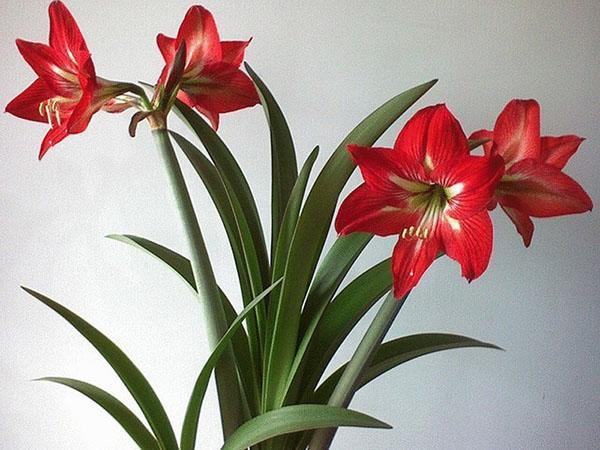Home care for hippeastrum
 Hippeastrum is grown at home like a green flower. This plant blooms very beautifully on the windowsill. Like all bulbous plants, hippeastrum spends the forces accumulated during the dormant period on flowering. This period occurs in autumn or winter, depending on the type of flower. In order for the plant to bloom, during the dormant period, watering is reduced, phosphorus and potassium-containing fertilizers are introduced into the soil, and the hippeastrum is transplanted into a spacious pot.
Hippeastrum is grown at home like a green flower. This plant blooms very beautifully on the windowsill. Like all bulbous plants, hippeastrum spends the forces accumulated during the dormant period on flowering. This period occurs in autumn or winter, depending on the type of flower. In order for the plant to bloom, during the dormant period, watering is reduced, phosphorus and potassium-containing fertilizers are introduced into the soil, and the hippeastrum is transplanted into a spacious pot.
In winter, nitrogen fertilizers cannot be applied to the soil, because hippeastrum will not enter a dormant period. He will continue active vegetation. New flower stalks and leaves will quickly use up all the nutrients stored in the bulb. After two seasons, the plant will begin to wilt and die.
How to put a plant at rest
In mid-September - early October, the hippeastrum should enter a dormant period, which will last approximately two months. The green mass of the plant will begin to fade gradually. If this does not happen, the green leaves should be folded in half and squeezed. The influx of nutrients to them will decrease, and the aerial part of the flower will dry out. Pot with hippeastrum must be removed from the window sill and placed in the back of the room to stop the growing season.
Hippeastrum will recover very quickly and form new flower stalks if, during the rest period, it is transplanted into a larger pot filled with fertile soil and fed with phosphorus and potassium fertilizers.
The entry of the hippeastrum during the active growing season
The hippeastrum leaves a state of rest in early March. At this time, a period of active vegetation begins, and the plant needs abundant watering and feeding. This is indicated by three factors:
- rapid growth of new peduncles;
- reduction of the bulb in diameter;
- drying out of the soil and the appearance of compaction on it.
During the active growing season, the flower is watered into a pan in order to avoid rotting of the bulb. Watering is done every three days. Once a week, one teaspoon of complex mineral and nitrogen-containing fertilizer is added to the soil. To accelerate flowering, you can add a third of a teaspoon of superphosphate to the soil, it is applied in solid form once every two weeks.
The flower will form three stalks, which will have buds. During flowering, you do not need to feed hyperstrum.